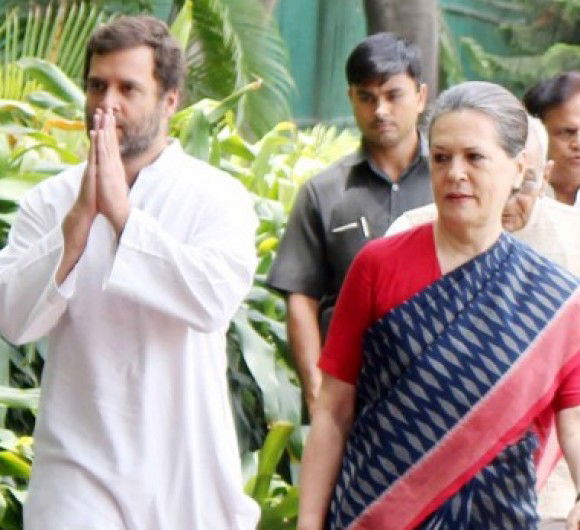Articles features
Is the Congress running fast to stand still?

Do page one photographs of Sonia Gandhi, Rahul Gandhi, Kumari Shelja,
Anand Sharma and Mohsina Kidwai agitating against suspension of
opposition members spell Congress revival?
Let us pick up
the thread from the build up to the election of May 2014. Everybody and
his neighbour had tried cajoling Rahul Gandhi to be a willing counter to
Narendra Modi - CII, FICCI, Arnab Goswami. But Rahul was a soufflé that
wouldn’t rise. He would speak in parables; he planned to reinvent the
party from grassroots, a 10-year project which, if it fructifies, will
see a 53-year-old Rahul at the helm. He has not announced any change of
heart yet.
What then is this hyper activity about? Surely, Sushma
Swaraj, Vasundhara Raje and Shivraj Singh Chauhan and the discomfiture
of the Sangh Parivar on that count are all custom made for any
opposition to seize upon. Are these treaties designed to affect the
Bihar vote?
Modi harvested the Congress-led United Progressive
Alliance’s discomfiture. Who in that page one photograph will reap the
benefits of their current exertions against him in and out of
parliament?
It is universally acknowledged that the Modi campaign
was carefully crafted by Corporate India, with help from a host of
outfits including APCO Worldwide Consultancy under the leaderships of
Timothy Roemer, former US ambassador to India. India was going to be
transformed into a Corporate Paradise which would provide new sinews to
the global economy in free fall (Joseph Stiglitz’s term) since 2008.
India
Inc, led by Modi acolytes like the Adani group, spent more money on the
Modi campaign than has ever been spent in the world’s electoral
history.
The campaign worked because the electorate was disgusted
with the two stars in our photo-frame plus Manmohan Singh. The Congress
was reduced to a rubble. Which is why Congress’ new found confidence,
so early in the proceedings, is puzzling, the scams notwithstanding.
A
massive publicity campaign plus a pulpy state of the principal
opposition brought Modi to power. An Arabic saying explains it
succinctly: not love of Ali but disgust with Muaviya was the operative
fundamental.
Modi had not come to power because he was loved by
the people. Nor was he admired by senior BJP leaders he foiled during
the 2013 Goa conclave in which he was nominated the party’s prime
ministerial candidate, despite their opposition. He was endorsed in the
hope that he would be “strongâ€.
Within six months of becoming
prime minister, had Modi also picked up the election to the Delhi
assembly as a trophy, the narrative today would have been very
different. But the Aam Admi Party (AAP) wiped out the Congress and the
BJP, in two elections in quick succession.
This petrified the
BJP, Congress, Big Business with huge stakes in Delhi, the police and
the section of Babudom prone to corruption. The AAP experiment had to be
crushed. The media was mobilized in this expedition. The Lt.
Governor-AAP stalemate in Delhi is part of this larger Ding-Dong.
In
this fashion, a year has passed and an impatient business community,
who have seen property prices in Delhi (for example) fall by about 40
percent, is restive. The famous Land Bill is neither here nor there.
There is plenty of Maan ki Baat on the radio and photo ops on foreign
trips, keeping up the delusion of energy, action, policy. But nothing of
substance, except for deteriorating law and order and rising prices.
Impatience
is now afflicting corporate India. Modi’s cheer leaders in the media
are turning upon him. Saner advice coming from former insiders may well
be heeded. Why must the next generations of reforms be restricted to
facilitating big business. These reforms should focus on governance, the
Panchayati Raj apparatus, education, health, rural housing, police
reform. There is no nodal point in Delhi that keeps a steady gaze on
Kashmir. The BJP-PDP government in Srinagar is floating on its own.
There is some indication the prime minister may make helpful
announcements in his August 15 utterances.
The important point is
that the business community, which had dreamed up the moon when Modi
first came to power, is now distributing its largesse, which include the
media it controls, to those stars in the photo frame too. To that
extent the current unending agitation could well be on queue. There is
no enunciation of new strategy. Rahul will visit Dalits, families of
farmers, flood hit areas, but never victims of communal violence,
confirming the Congress as a party similar to the BJP minus the Sadhus.
Of
course, no one is for a moment suggesting that there is smoke without
fire. The three scams do hang around the BJP’s neck. But the shifting of
Corporate favours away from Modi in the direction of the Congress once
again ignores the people. Are the two national parties seeking comfort
in Corporate munificence? This is at the heart of what is now being
understood even by common people as crony capitalism.
Voters
have recoiled on this arrangement in Latin America, Indonesia, Greece,
Scotland, Spain - even in Delhi. They may not have discovered the third
way but they are searching for it. If the Corporates, BJP and the
Congress persist with their troika dance at the centre, the people will,
over a period of time, make themselves heard in the regions.
In
the long run, this is good for federalism. But it will dilute
centralized power which is the dream of the ruling class as exemplified
by the Congress and the BJP -- tweedledum and tweedledee.
(A
senior commentator on political and diplomatic affairs, Saeed Naqvi can
be reached on saeednaqvi@hotmail.com. The views expressed are personal.)



































